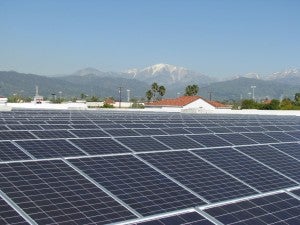More Companies Turning to Distributed Generation – What Does it Mean for Utilities?
Last month, the Wall Street Journal reported on an initiative at an increasing number of companies nationwide: on-site, or distributed, power generation. There are many reasons for this growing trend in corporate sustainability, along with many ramifications for the prevailing utility model in the United States – all of which highlight the importance of employing market-based solutions to create a cleaner, smarter, more resilient electric system.
Why Do Companies Unplug?
For companies such as Walmart, increasing the use of distributed, renewable generation is a vital part of larger sustainability goals, including increased use of clean energy and a call for safer ingredients used in the products the company sells. To be sure, however, even the most altruistic companies would be hard pressed to shift off the power grid without sound economic reasons.
A confluence of market factors, including tax incentives that spur attractive returns on investment, advances in solar and wind technologies and policies that encourage greater use of and investments in clean energy (like net metering and time-of-use pricing), has created an economic environment that makes distributed generation not just a viable option, but often a very attractive one. Further, off-grid power can be an effective way for companies to hedge against outages due to storms or unforeseeable catastrophes, a key idea included in the Hurricane Sandy Rebuilding Strategy.
What About Utilities?
FERC Chairman Jon Wellinghoff, speaking in April at a high-level meeting hosted by the Princeton Energy and Environment Corporate Affiliates Program, called the situation “a monumental challenge.”
As distributed generation becomes more common, utilities face unprecedented economic threats, summarized in a blunt report from the Edison Electric Institute (EEI) earlier this year. NRG Energy CEO David Crane has likened the outlook for utilities to the plight of the U.S. Postal Service, warning of a downward spiral where increased distributed power cuts into regulated utility revenue, in turn forcing utilities to raise rates, thereby driving more customers to off-grid generation.

What’s Next?
Speaking at the same Princeton meeting in April, EDF’s own Mark Brownstein noted that “there is no shortage of academic studies that envision a future of distributed generation and large-scale renewable deployment.” But while distributed generation grows, utilities still look to dominate the power business for years to come. That’s why it is imperative that we keep working with all parties to put the right rules in place for a smarter, more flexible energy system.
A chapter in America’s Power Plan suggests that policy can support distributed generation though fair economic incentives and clear cost-allocation methods, while moving toward new regulatory and business models for utilities that separate revenues from the amount of electricity sold. We must work toward this new energy paradigm by aligning incentives for utilities and customers, and advocating for new financing mechanisms, such as on-bill repayment, to promote clean, distributed energy investments. We must continue to modernize our outdated electric grid to accommodate new, on-site, clean power sources.
While changes to the existing energy system may be incremental, these types of market-based solutions are the most effective path toward a cleaner, smarter energy future.











